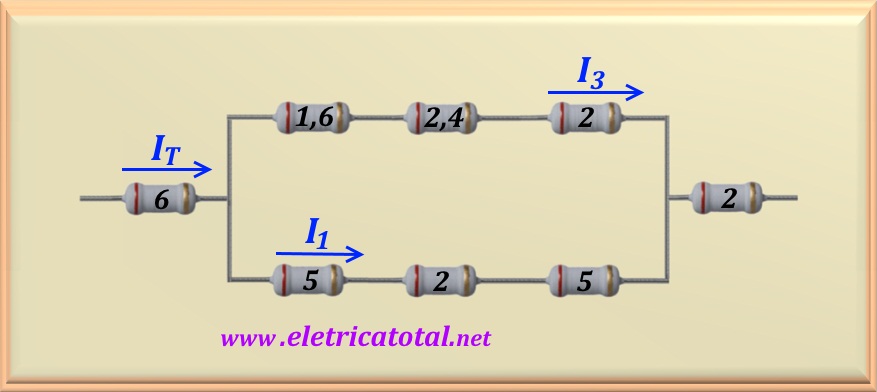Problem 10-16 Source:
Problem elaborated by the author of the site.
In the circuit show in Figure 10-16.1, determine:
a) The value of IT.
b) The values of I1 , I2 and I3.
c) The power dissipated in the resistor of 1.6 Ω.
Solution of the Problem 10-16
In order to calculate the current IT, one must calculate the
equivalent resistance of the entire circuit. It is possible to calculate the
equivalent resistance of the left branch where the currents circulate
I1 and I2. Making the parallel of the
6 ohms and 3 ohms resistors yields 2 ohms. Now there
are three resistors in series. In addition to its values,
Resq = 5 + 2 + 5 = 12 ohms. Now doing the right branch,
there is the parallel of the 6 ohms and 4 ohms resistors resulting
in 2.4 ohms. Then, the equivalent resistance of the right branch is
Rdir = 1.6 + 2.4 + 2 = 6 ohms
The Figure 10-16.1 shows how simplified the circuit was.
The next step is to determine the value of the parallel between
Resq and Rdir, values as calculated above.
Using the equation that allows to calculate the parallel between two resistors:
Making the substitution by the numerical values and performing the calculation:
To find the equivalent resistance value of the whole circuit, simply calculate
the series of three resistors. Like this:
To compute the IT value, simply apply the Ohm law, or:
To calculate I1 and I3 simply apply a current divider to the circuit above. Remembering that Resq = 12 Ω and Rdir = 6 Ω, so:
In order to find the value of I2, we must pay attention to the initial circuit and verify that this current is a derivative of I1. Then, by applying a current divider:
In order to calculate the power that the 1.6 Ω resistor dissipates, it is sufficient to verify that the current circulates through it is I3 = 3 A. Then, applying the equation studied in Chapter 7 we have:



